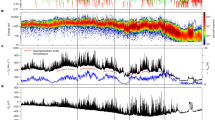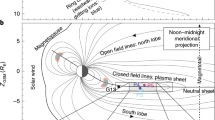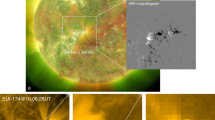Abstract
Magnetic reconnection in a current sheet converts magnetic energy into particle energy, a process that is important in many laboratory1, space2,3 and astrophysical contexts4,5,6. It is not known at present whether reconnection is fundamentally a process that can occur over an extended region in space or whether it is patchy and unpredictable in nature7. Frequent reports of small-scale flux ropes and flow channels associated with reconnection8,9,10,11,12,13 in the Earth's magnetosphere raise the possibility that reconnection is intrinsically patchy, with each reconnection X-line (the line along which oppositely directed magnetic field lines reconnect) extending at most a few Earth radii (RE), even though the associated current sheets span many tens or hundreds of RE. Here we report three-spacecraft observations of accelerated flow associated with reconnection in a current sheet embedded in the solar wind flow, where the reconnection X-line extended at least 390RE (or 2.5 × 106 km). Observations of this and 27 similar events imply that reconnection is fundamentally a large-scale process. Patchy reconnection observed in the Earth's magnetosphere is therefore likely to be a geophysical effect associated with fluctuating boundary conditions, rather than a fundamental property of reconnection. Our observations also reveal, surprisingly, that reconnection can operate in a quasi-steady-state manner even when undriven by the external flow.
This is a preview of subscription content, access via your institution
Access options
Subscribe to this journal
Receive 51 print issues and online access
$199.00 per year
only $3.90 per issue
Buy this article
- Purchase on Springer Link
- Instant access to full article PDF
Prices may be subject to local taxes which are calculated during checkout



Similar content being viewed by others
References
Pare, V. K. in Magnetic Reconnection in Space and Laboratory Plasmas (ed. Hones, E. W.) 341–346 (Geophysics Monograph 30, American Geophysical Union, Washington DC, 1984)
Cowley, S. W. H. in Magnetic Reconnection in Space and Laboratory Plasmas (ed. Hones, E. W.) 375–378 (Geophysics Monograph 30, American Geophysical Union, Washington DC, 1984)
Priest, E. R. in Magnetic Reconnection in Space and Laboratory Plasmas (ed. Hones, E. W.) 63–78 (Geophysics Monograph 30, American Geophysical Union, Washington DC, 1984)
Duncan, R. & Thompson, C. Formation of very strongly magnetized neutron stars: implications for gamma-ray bursts. Astrophys. J. 392, L9–L13 (1992)
Hurley, K. et al. An exceptionally bright flare from SGR 1806–20 and the origins of short-duration γ-ray bursts. Nature 434, 1098–1103 (2005)
Kronberg, P. P. Intergalactic magnetic fields. Phys. Today 55, 40–46 (2002)
Nishida, A. Can random reconnection on the magnetopause produce the low latitude boundary layer? Geophys. Res. Lett. 16, 227–230 (1989)
Russell, C. T. & Elphic, R. C. Initial ISEE magnetometer results: Magnetopause observations. Space Sci. Rev. 22, 681–715 (1978)
Paschmann, G. et al. Plasma and magnetic characteristics of magnetic flux transfer events. J. Geophys. Res. 87, 2159–2168 (1982)
Owen, C. J. et al. Cluster PEACE observations of electrons during magnetospheric flux transfer events. Ann. Geophys. 19, 1509–1522 (2001)
Sonnerup, B., Hasegawa, H. & Paschmann, G. Anatomy of a flux transfer event seen by Cluster. Geophys. Res. Lett. 31, doi:10.1029/2004GL020134 (2004)
Nakamura, R. et al. Spatial scale of high-speed flows in the plasma sheet observed by Cluster. Geophys. Res. Lett. 31, doi:10.1029/2004GL019558 (2004)
Louarn, P. et al. Cluster observations of complex 3D magnetic structures at the magnetopause. Geophys. Res. Lett. 31, doi:10.1029/2004GL020625 (2004)
Phan, T. D. et al. Extended magnetic reconnection at the Earth's magnetopause from detection of bi-directional jets. Nature 404, 848–850 (2000)
Fuselier, S. A. et al. Cusp aurora dependence on IMF Bz . J. Geophys. Res. 107, 1111, doi:10.1029/2001JA900165 (2002)
Pinnock, M. et al. The location and rate of dayside reconnection during an interval of southward interplanetary magnetic field. Ann. Geophys. 21, 1467–1482 (2003)
Gosling, J. T. et al. Direct evidence for magnetic reconnection in the solar wind near 1AU. J. Geophys. Res. 100, doi:10.1029/2004JA010809 (2005)
Gosling, J. T. et al. Magnetic disconnection from the Sun: Observations of a reconnection exhaust in the solar wind at the heliospheric current sheet. Geophys. Res. Lett. 32, doi:10.1029/2005GL022406 (2005)
Petscheck, H. E. in AAS-NASA Symp. on the Physics of Solar Flares (28–30 October 1963, Goddard Space Flight Centre, Greenbelt, Maryland) (ed. Hess, W. N.) 425–437 (NASA Spec. Publ. SP-50, NASA Science and Technical Information Division, Washington DC, 1964).
Sonnerup, B. U. Ö. & Cahill, L. J. Jr Magnetopause structure and attitude from Explorer 12 observations. J. Geophys. Res. 72, 171–183 (1967)
Sonnerup, B. U. Ö. Magnetopause reconnection rate. J. Geophys. Res. 79, 1546–1549 (1974)
Gosling, J. T. et al. Evidence for quasi-stationary reconnection at the dayside magnetopause. J. Geophys. Res. 87, 2147–2158 (1982)
Frey, H. et al. Continuous magnetic reconnection at Earth's magnetopause. Nature 426, 533–537 (2003)
Phan, T. D. et al. Cluster observations of continuous reconnection at the magnetopause under steady interplanetary magnetic field conditions. Ann. Geophys. 22, 2355–2367 (2004)
Paschmann, G. et al. The magnetopause for large magnetic shear: AMPTE/IRM observations. J. Geophys. Res. 91, 11099–11115 (1986)
Hudson, P. D. Discontinuities in an anisotropic plasma and their identification in the solar wind. Planet. Space Sci. 18, 1611–1622 (1970)
Acknowledgements
Wind, ACE and Cluster research in the US is supported by NASA. Cluster research in France and the UK is supported by CNES and PPARC.
Author information
Authors and Affiliations
Corresponding author
Ethics declarations
Competing interests
Reprints and permissions information is available at npg.nature.com/reprintsandpermissions. The authors declare no competing financial interests.
Rights and permissions
About this article
Cite this article
Phan, T., Gosling, J., Davis, M. et al. A magnetic reconnection X-line extending more than 390 Earth radii in the solar wind. Nature 439, 175–178 (2006). https://doi.org/10.1038/nature04393
Received:
Accepted:
Issue Date:
DOI: https://doi.org/10.1038/nature04393
This article is cited by
-
Recent progress on magnetic reconnection by in situ measurements
Reviews of Modern Plasma Physics (2023)
-
Direct observation of turbulent magnetic reconnection in the solar wind
Nature Astronomy (2022)
-
Nonlinear dynamics in space plasma turbulence: temporal stochastic chaos
Reviews of Modern Plasma Physics (2022)
-
Bifurcated outflow jet in a solar wind reconnection exhaust
Astrophysics and Space Science (2021)
-
Fluid and kinetic aspects of magnetic reconnection and some related magnetospheric phenomena
Reviews of Modern Plasma Physics (2020)
Comments
By submitting a comment you agree to abide by our Terms and Community Guidelines. If you find something abusive or that does not comply with our terms or guidelines please flag it as inappropriate.



